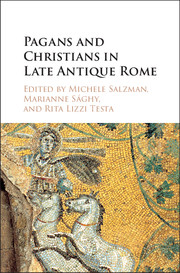 Pagans and Christians in Late Antique Rome
Pagans and Christians in Late Antique Rome from Section B - Death and the Afterlife
Published online by Cambridge University Press: 05 November 2015
To understand the complex processes of change that Roman society underwent with the advent and expansion of Christianity, scholars of the late antique and early Christian period have used cultural memory theory as an interpretive model. Despite the criticisms that may be raised against this approach, from vagueness and lack of terminology, to theoretical exaggeration, the efforts (whether conscious or unconscious) of late Roman people to establish a new collectively shared memory about their Christian past may be detected in and across diverse groups of Christian Romans – from the lower and middle classes to senators and emperors. Such efforts may be seen in the establishment of narratives and commemorative practices with respect to the new Christian guardians of Rome: the apostles and the martyrs. This chapter will discuss one of these commemorations, the festival honoring the Apostles Peter and Paul on June 29, and the narratives supporting it – ancient as well as modern.
According to tradition, Peter and Paul were the founders of the Roman Church by their joint martyrdom at Rome. The memory of the two apostles was anchored to Rome by way of their graves, which were, in fact, called memoriae. These memoriae were monumentalized with shrines donated by emperors, praised by poets, and visited by pilgrims throughout the year, but especially around the annual festival on June 29. On this day, the reenactment of the memory of the Apostles also took place at the so-called Memoriae Apostolorum on the Via Appia, today's S. Sebastiano. Six hundred graffiti from the third century onward contain prayers of intercession devoted to Peter and Paul, thus testifying to a joint cult of these apostles – all year round. In the second half of the fourth century, the cult and the festival on June 29 was intensified by Pope Damasus (366–84) who composed an epigram for Peter and Paul at the Memoriae Apostolorum.
For more than two centuries, a considerable number of scholars have claimed that the celebration of Saints Peter and Paul on June 29 reflected an effort, during the third century, to appropriate an existing celebration on the same day of the divine founder of Rome, Romulus/Quirinus. In this chapter it will be argued, however, that this narrative about a Christian “usurpation” of a pagan celebration of Rome's foundation is a misguided modern construction of religious politics and cultural memory in fourth- and fifth-century Rome.
To save this book to your Kindle, first ensure [email protected] is added to your Approved Personal Document E-mail List under your Personal Document Settings on the Manage Your Content and Devices page of your Amazon account. Then enter the ‘name’ part of your Kindle email address below. Find out more about saving to your Kindle.
Note you can select to save to either the @free.kindle.com or @kindle.com variations. ‘@free.kindle.com’ emails are free but can only be saved to your device when it is connected to wi-fi. ‘@kindle.com’ emails can be delivered even when you are not connected to wi-fi, but note that service fees apply.
Find out more about the Kindle Personal Document Service.
To save content items to your account, please confirm that you agree to abide by our usage policies. If this is the first time you use this feature, you will be asked to authorise Cambridge Core to connect with your account. Find out more about saving content to Dropbox.
To save content items to your account, please confirm that you agree to abide by our usage policies. If this is the first time you use this feature, you will be asked to authorise Cambridge Core to connect with your account. Find out more about saving content to Google Drive.